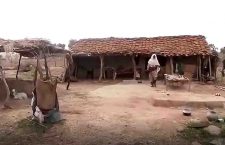“Koi Ajaygarh mein, koi Panna mein, koi Kartal mein, jagah jagah mein log pareshan hain (In Ajaygarh, Panna, Kartal, everywhere people are struggling)”, says Vineeta, a resident of Lodha Purva village, Ajaygarh Block, in the Panna district of Madhya Pradesh. The cause of all her woes? The lack of potable water in her village.
Prolonged consumption of the contaminated water of the Lodha Purva village well has led to the death of two people, and the hospitalisation of twenty five others.
Vineeta laments, “The water in the well is dirty. And all the water that we use to bathe or wash also goes into the same well. Drinking that water causes nausea, diarrhoea, and stomach aches. If we could have a tap installed, this problem could be resolved/solved.”
The situation was first diagnosed after a spate of illnesses broke out across the village. Sandeep, brother of the deceased, says resignedly, “Suddenly everyone in the house had fever and was throwing up violently. My brother and sister passed away. Everyone else is still sick — my mother, my father, and brother. They are currently in the Naraini Government Hospital. They fell ill after drinking the contaminated water from the well.”
Maya, an anganwadi worker, briefs us on the situation, “Initially, a young girl was taken to Allahabad for treatment, after severe vomiting. People assumed that she died because of a sunstroke. No one paid any attention. But after that, there was a similar case almost every two days — people in every household were falling sick, with the same symptoms. After that I personally called 108, and told them about the situation here, and asked them to conduct an investigation. The ambulance arrived and took all the patients. After that, district-level officials took samples of the water and surveyed the situation. They said the samples would be sent for analysis to a forensic lab.”
Government officials have been notified. They have conducted surveys/inquiries and have promised to take action and install a hand pump in the village. India has more people in rural areas – 63.4 million – living without access to clean water, than any other country, according to a report by WaterAid, a global advocacy group on water and sanitation. Arsenic or iron contamination, pollution of groundwater, the lack of piped water, and depleting aquifers are just some of the causes of this shortage of potable water in villages. In Lodha Purva, the water from the well is contaminated by domestic effluents, animal waste, dung, and refuse. Yet, despite the existence of an alternate hand pump in the village and the alarming rise of water-borne and contaminant related illnesses, the villagers continue to regularly use the well.
“There is only one hand-pump, on the other side of the village — where the harijans stay. We’re brahmin and thakur, and believe in untouchability. Plus, there are more people on that side of the village, so we use the well since it’s also closer. We’ve never had a problem before, that gave us an indication that there was something wrong with the water or that it was polluted,” says Maya, matter-of-factly.
When asked to comment on the situation in Lodha Purva, Rajaram Prajapati the secretary of the village panchayat, stated, “First, we’ve organised the supply of water from tankers, so there is no scarcity of water. And in any case, there’s always the hand-pump. There’s no issue with the availability of water!” Little does he know that Lodha Purva is grappling with its own unique intersection of problems: caste bias meets water scarcity and disease, presenting a conundrum that will require a multi-pronged approach to solve.


